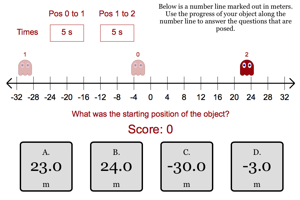
|
Make sure you can distinguish between the terms displacement/distance and speed/velocity. Show that you can apply these terms to an object that goes through a series of different motions. You are doing these for your own review, so you don't need to share your screen shots with your instructors. |
|
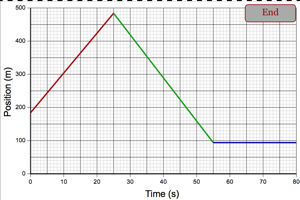
|
Make sure you can find the velocity of an object based on the position vs. time graph that it creates. |
|
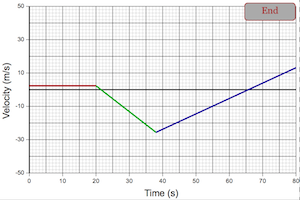
|
Make sure that you remember how to find the displacement of an object based on the velocity vs. time graph that it created while it was moving. |
|
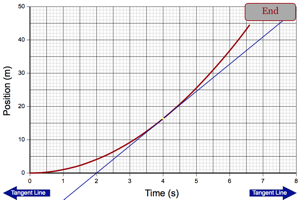
|
Make sure you can get the instantaneous velocity of an object based on its position vs. time graph. |
|
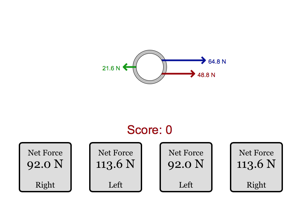
|
Take one minute to make sure you can get the net force from multiple forces all acting in the same dimension. |
|
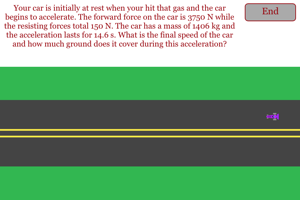
|
Make sure you remember how to use the equations of motion for a car that is accelerating for a set amount of time. |
|
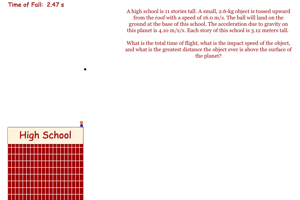
|
Students will maximum height obtained by an object tossed upward off the roof of a high school. They will also find the total time aloft and the speed with which the object will impact the ground. The acceleration due to gravity on this planet will be given to you. |
|
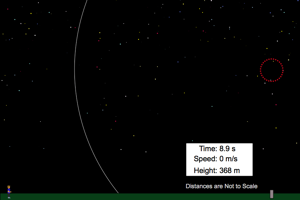
|
Students will find the maximum height and the time to reach the maximum height for a firework that is fired vertically upward and explodes at the point where it would have started coming back down again. |
|
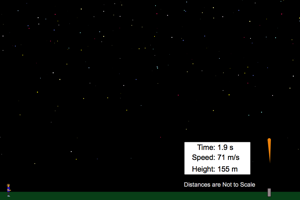
|
Students will find the maximum height and the time to reach the maximum height for a firework that is fired vertically upward and explodes at the point where it would have started coming back down again. Information about the planet will be given to them so that they can work out the acceleration due to gravity on that planet. |
|
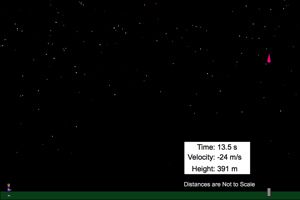
|
Students will find the explosion height and the time to explosion for a firework that is fired vertically upward and explodes at the point where it already coming back down again. Information about the planet will be given to them so that they can work out the acceleration due to gravity on that planet. |
|
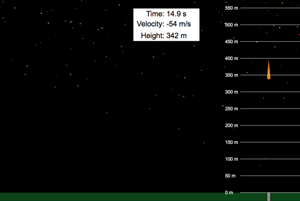
|
Students will set the launch speed and fuse time for a firework so that the firework will explode at the desired height and speed. This problem does not take place on Earth. |
|
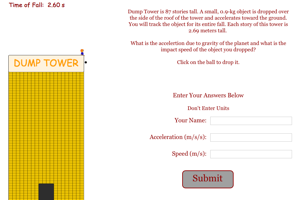
|
Students must find the acceleration due to gravity on a planet and the impact speed of an object that has been falling from the top of a garish tower. |
|
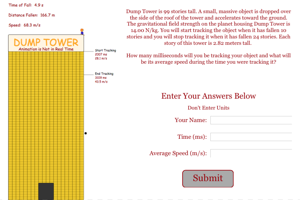
|
Students must find the time it has been falling and the average speed it has been falling between to stories of a garish tower. |
|
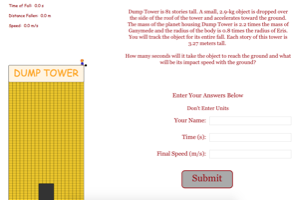
|
Students will be given information about a planet and they must calculate how long it takes an object to fall from the top of a garish tower. |
|
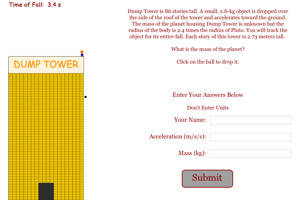
|
Students will try to determine the mass of a planet based on the falling of an object from the top of a garish tower. |
|
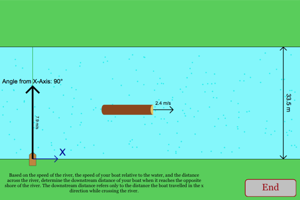
|
Make sure you can figure out the downstream distance that a boat travels when its heading relative to the water is perpendicular to the way the water is moving. |
|
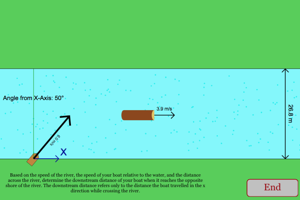
|
Make sure you can figure out the downstream distance that a boat travels when its heading relative to the water is not perpendicular to the way the water is moving. |
|
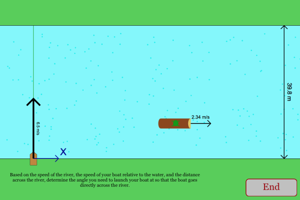
|
Make sure you can figure out the angle they need to point the boat so that the boat moves directly across the water. |
|
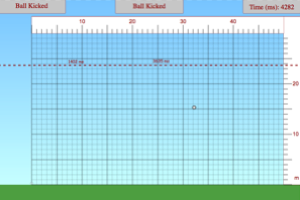
|
Students must determine when a soccer ball reaches a given height based on the velocity with which it is kicked. Students are reminded that the ball will reach this height twice, once on the way up and once on the way down. Students must find both times and put them in milliseconds. This problem does not take place on Earth. |
|
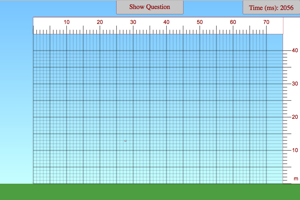
|
Students must determine the initial velocity of a soccer ball based on the horizontal displacement and the time of flight. This problem does not take place on Earth. |
|
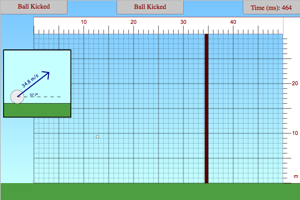
|
Students must determine where a soccer ball will hit a wall based on the speed with which it is kicked. Students will also need to find the time in the air in milliseconds. This problem does not take place on Earth. |
|
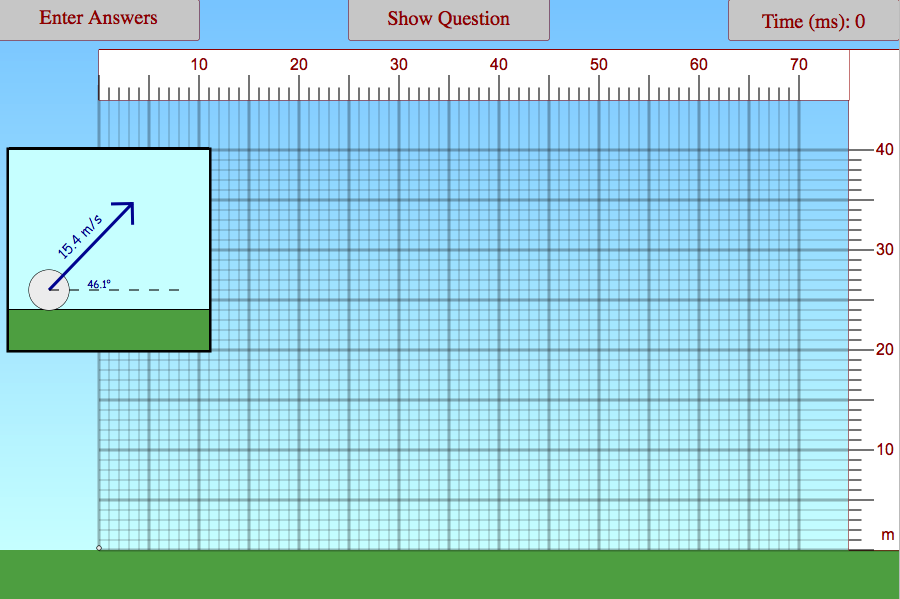
|
Students must determine where a soccer ball will land based on the speed with which it is kicked. Students will also need to find the time in the air and the maximum height obtained by the projectile. This problem does not take place on Earth. |
|
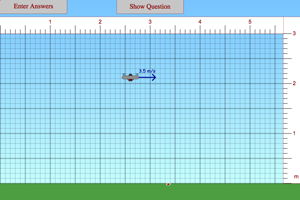
|
Students must determine where a drone should be when it releases its package so that the object lands on the target. |
|
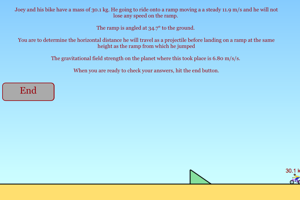
|
Make sure you can determine the landing location of a projectile that starts and ends at the same height. |
|
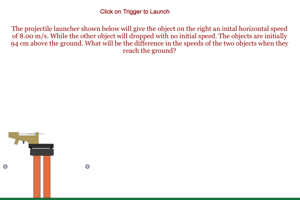
|
Students must predict the difference in the landing speeds of two projectiles. |
|
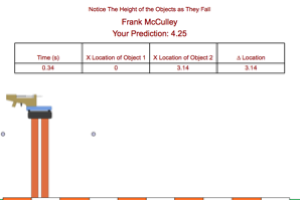
|
Students must predict the difference in the landing locations of two projectiles. |
|
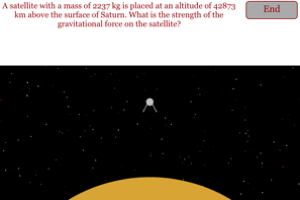
|
Make sure you know how to calculate the gravitational force on a satellite in orbit around one of the objects in our solar system. |
|
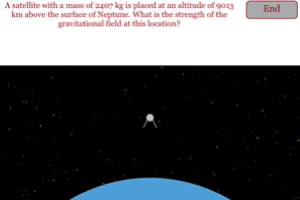
|
Make sure you know how to calculate the gravitational field at the location of a satellite in orbit around one of the objects in our solar system. |
|
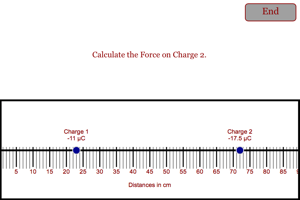
|
Make sure you can find the force on one charge caused by a second charge. |
|
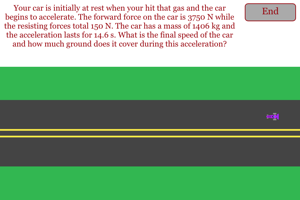
|
Make sure you can find stopping distance for an object under the influence of friction. |
|
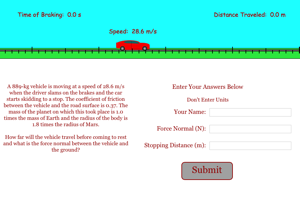
|
Students must calculate the stopping distance for a car traveling on a distant planet. |
|
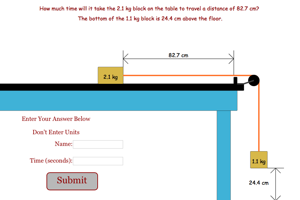
|
Students must find the time that it takes for the block to move across the table. This will involve an acceleration and a period of travel at a constant speed. |
|
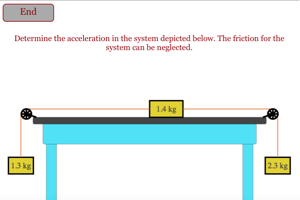
|
Students must find out different things for a series of 3 objects moving as a system. |
|
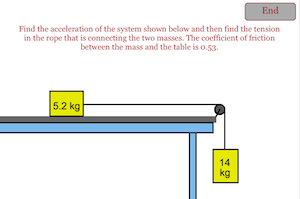
|
Make sure that you can solve for the acceleration of a system and the force of tension that is internal to the system. |
|
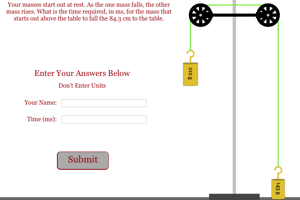
|
Make sure you can find out the time it takes a mass on an Atwood Machine to fall a certain distance. |
|
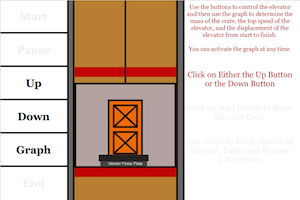
|
Make sure you can calculate things about an object in a elevator simply based on the force-time graph that is produced as the object rides in the elevator. |
|
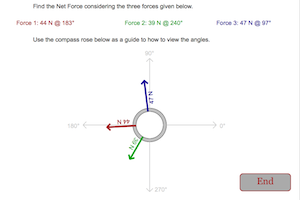
|
Make sure you can find the net force when the forces involved are at random angles. |
|
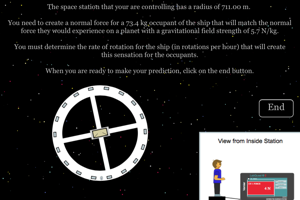
|
Make sure you can work with the forces on an object moving in circular motion. |
|
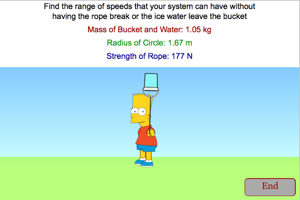
|
Students must calculate the maximum and minimum speeds for a bucket whirled in a vertical circle. |
|
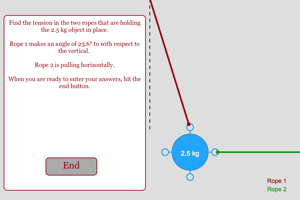
|
Make sure you can find the tension in two ropes when one of the ropes is horizontal. |
|
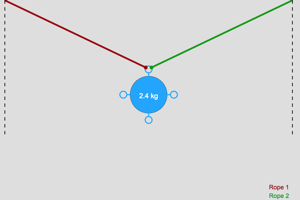
|
Make sure you can find the tension in two ropes when the ropes are pulling at equal angles. |
|
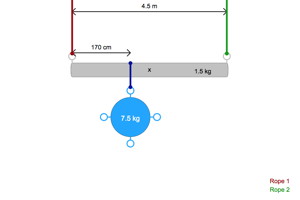
|
Make sure you can find the tension in two ropes that are holding the system in static and rotational equilibrium. |
|
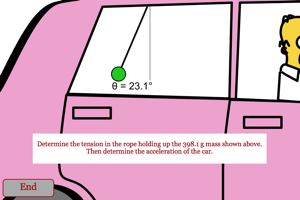
|
Make sure you can deal with situation where acceleration of the car is causing an angular displacement for a hanging mass. |
|
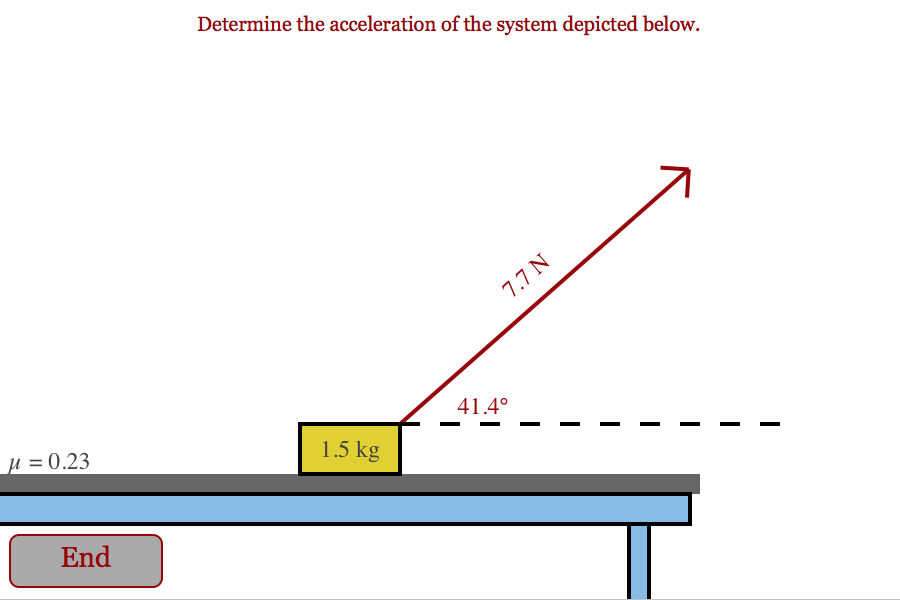
|
Make sure you can calculate the acceleration of an object being pulled along a horizontal surface by a force on an angle. The surface has friction. |
|
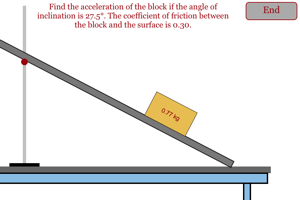
|
Make sure you can calculate the acceleration of an object down an incline when there is friction present. Mass, angle and coefficient of friction will be generated randomly. |
|
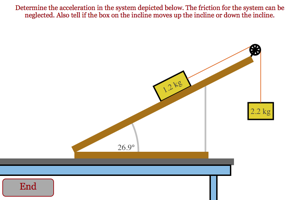
|
Make sure you can find out the acceleration of a system including an incline. |
|
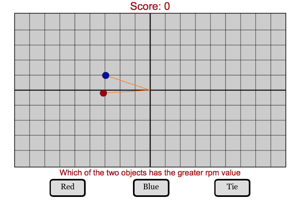
|
Make sure you can apply your knowledge of circular motion correctly answer as many questions as possible in two minutes. |
|
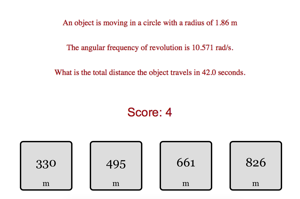
|
This challenge is designed to help students move back and forth from different circular motion ideas. These ideas include frequency, rpm, period, angular speed, linear speed, total distance and total radians. |
|
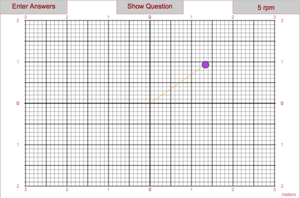
|
Students must determine speed and rpm of a object on a string at the moment when the string snaps that is holding the ball in a circular path. |
|
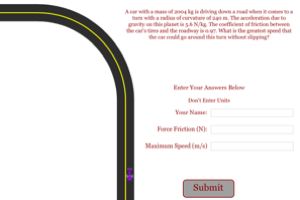
|
Students must determine the force of friction on a car on a turn and the maximum speed the car could navigate a turn. |
|
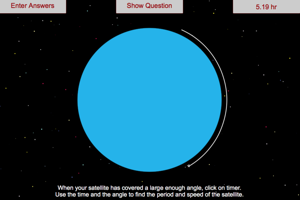
|
Students must determine speed of a satellite by timing the satellite for part of its orbit. Students must also determine the period of the orbit based on their timing. |
|
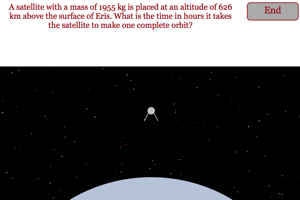
|
Make sure you can calculate the period of a satellite moving around one of the bodies in our solar system. |
|
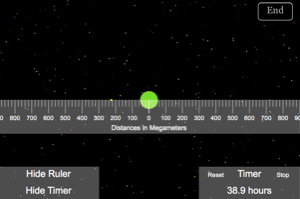
|
Make sure you can calculate the mass of a planet based on the orbital motion of the moon going around the planet. |
|
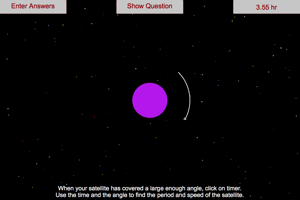
|
Students must determine mass of a planet based on the orbital motion of a satellite around the planet. |
|
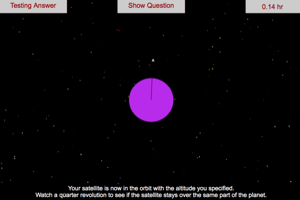
|
Students must calculate the altitude of a satellite that is in a geosynchronous satellite going around the planet. |
|
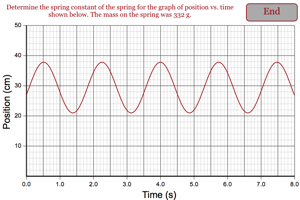
|
Make sure you can calculate the spring constant of a spring based on the oscillation graph that is created by an oscillating mass. |
|
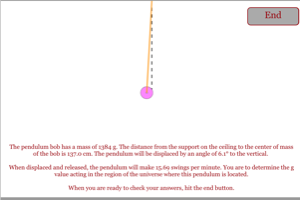
|
Students must calculate the strength of the gravitational field based on the swinging motion of a pendulum. |
|
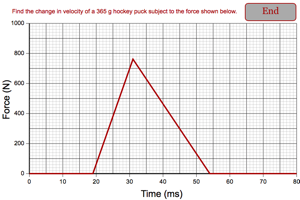
|
Make sure you calculate the speed of a hockey puck based on the graph of force vs. time for the impact between the stick and the puck. |
|
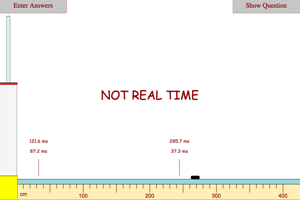
|
Students must calculate the impulse given to a hockey by the boards. The puck will collide with the boards and bounce off in the opposite direction. |
|
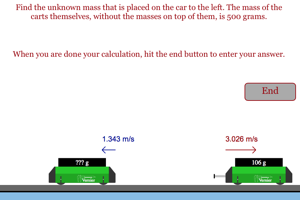
|
Make sure you can determine the unknown mass in a problem involving momentum conservation. Both objects begin at rest and are propelled apart by a tap activated spring. |
|
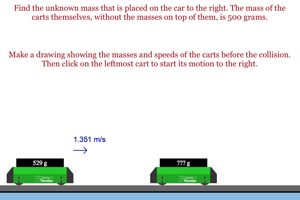
|
Make sure you can determine the unknown mass in a problem involving momentum conservation. One object begins at rest and the two objects stick together during the collision. |
|
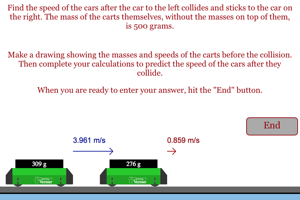
|
Make sure you predict the speed in a problem involving momentum conservation. One object overtakes the other and the two objects stick together during the collision. |
|
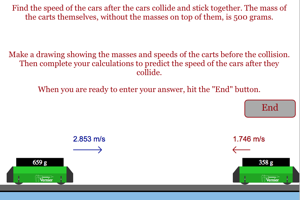
|
Make sure you can predict the speed in a problem involving momentum conservation. The two objects have a head-on collision and stick together during the collision. |
|
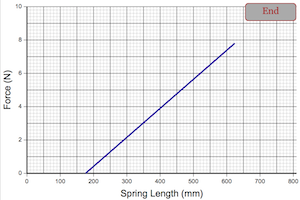
|
Make sure you can find out how much energy has been added to a spring by looking at the Force vs. Spring Length graph. |
|
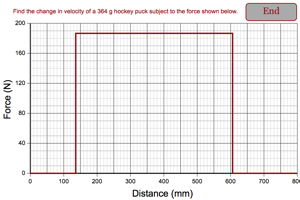
|
Make sure you can determine the speed of a hockey puck based on a graph of force vs. displacement. |
|
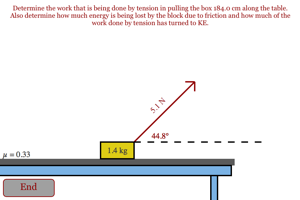
|
Students must determine the amount of work that is done by tension and the amount of work done by friction. Then students must find the work that turned into KE. |
|
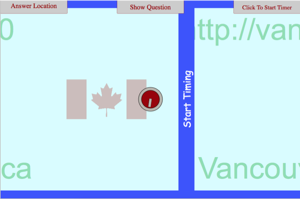
|
Students must determine the kinetic energy of a curling stone based on the time it takes to move between two markings on the ice. |
|
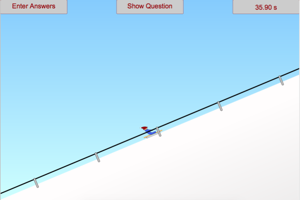
|
Students must determine the power that is being exerted by a motor to pull a person up a frictionless incline. |
|
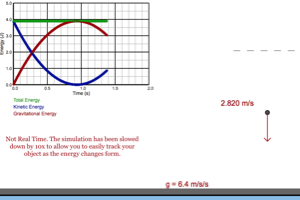
|
Make sure you can predict the maximum height reached by an object based on energy conservation. |
|
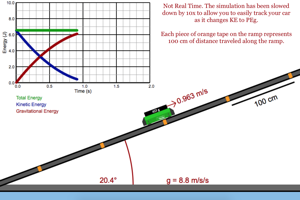
|
Make sure you can predict the distance a cart will move up an incline based on energy conservation. |
|
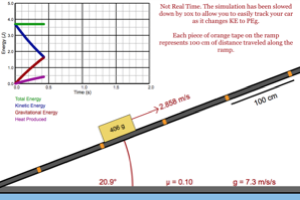
|
Make sure you can predict the distance a box will move up an incline based on energy conservation. There will be friction present and some of the original KE will turn into heat. |
|
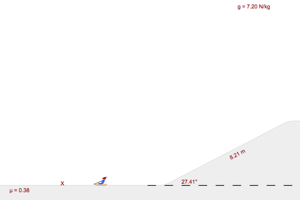
|
Make sure you can predict the distance traveled by a person on a sled. The person will start with potential energy due to gravity and it will turn into KE without loss. They will then lose their energy on a level surface at the bottom of a hill. You have to predict how far they will travel on the horizontal section of their travel. |
|
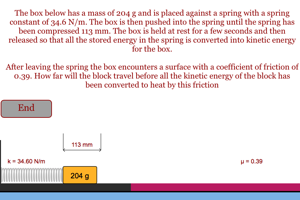
|
Students must predict the distance traveled by a box that has been projected horizontally by a compressed spring. The box will start with potential energy due to elasticity and it will turn into KE without loss. It will then lose its energy on a level surface that has significant amounts of friction. You have to predict how far the box will travel on the rough section of its travel. |
|
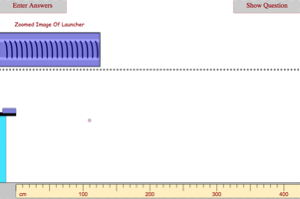
|
Students must find the spring constant of a spring based on the distance a projectile travels when fired by the spring. |
|
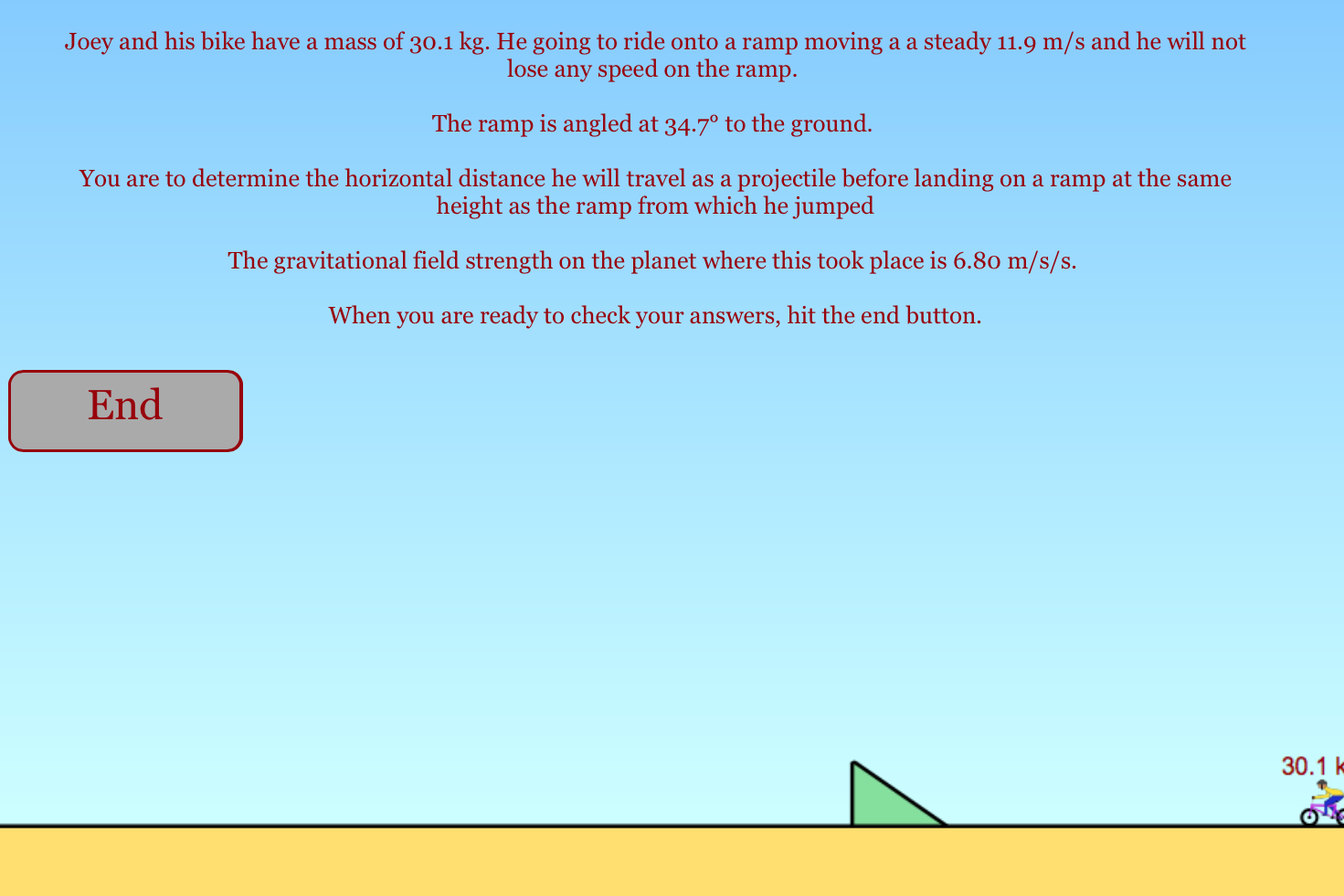
|
Students must find the distance that Joey will travel as a projectile based on the kinetic energy that he possesses. |
|
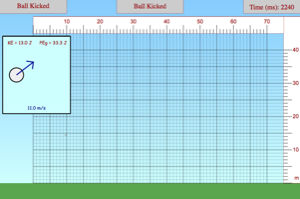
|
Students must predict the maximum height reached by a projectile based on energy conservation. |
|
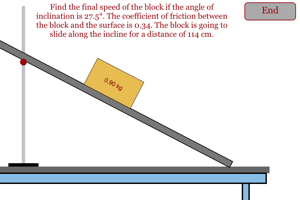
|
Make sure you can predict the final speed of the block on the incline after sliding down a certain distance. Students must account for the energy lost due to the friction between the block and the incline. |
|
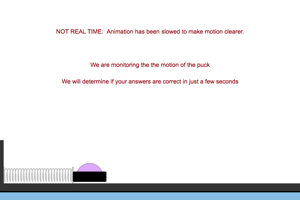
|
Make sure you can predict the amplitude and frequency of oscillation for a hovercraft getting stuck to a spring. |
|
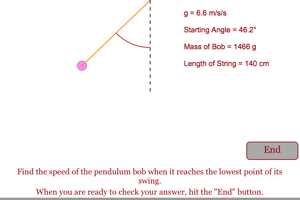
|
Make sure you can predict the speed a pendulum bob will have after it has reached the lowest point of its swing. |
|
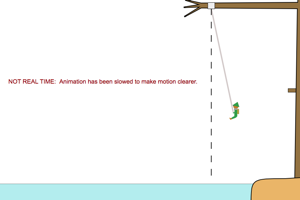
|
Make sure you can predict how far Robin Hood will move horizontally as he first swings like a pendulum and then sails like a projectile into a lake below. |
|
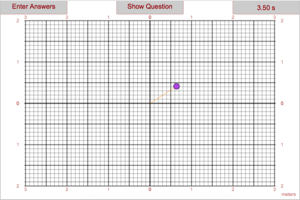
|
Students must determine the kinetic energy of a ball moving in a circular path. |
|
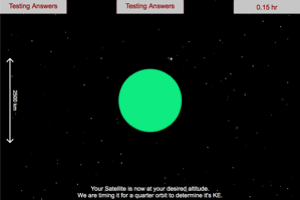
|
Students must determine the kinetic energy of a satellite as it orbits around a planet. |
|
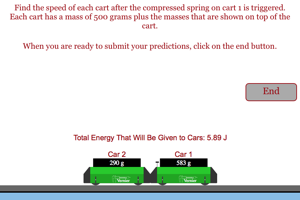
|
Make sure you can predict the speed of each car based on the total energy added to the two carts by the spring. |
|
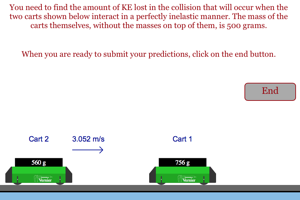
|
Make sure you can determine the amount of KE lost in a perfectly inelastic collision. |
|
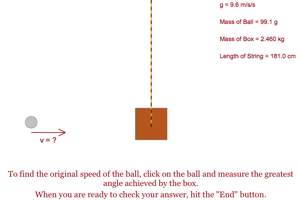
|
Make sure you can predict the pre-collision speed of a ball that has been captured by a ballistic pendulum. |
|
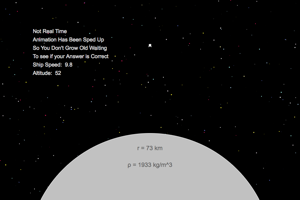
|
Make sure you can predict the speed of an object if it is to escape from a Kuiper Belt object. |
|
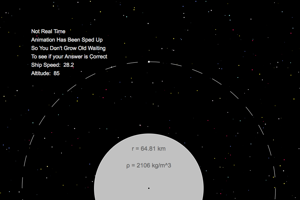
|
Make sure you can predict the speed of an object if it is to climb to a certain height above a Kuiper Belt object. |
|
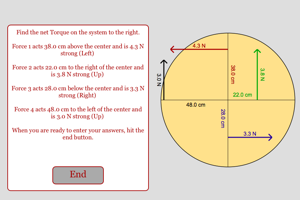
|
Make sure you can determine the net torque on a wheel. There will be four forces on the wheel and all of them will be at right angles to the radius from the center of the wheel. |
|
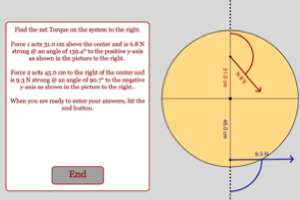
|
Make sure you can determine the net torque on a wheel. There will be two forces on the wheel that will be apply at random angles to their radii. |
|
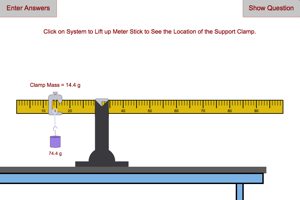
|
Determine the mass of a meter stick that is being balanced by a known mass. The center of mass for the meter stick is located at the 50.0 cm mark. |
|
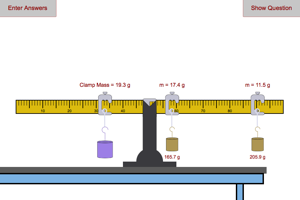
|
Determine the unknown mass that is being balanced by two known masses for a meter stick balanced at its center of mass (50.0 cm mark). |
|
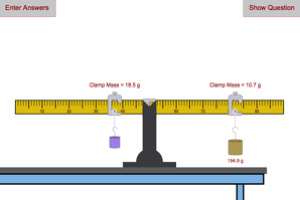
|
Determine the unknown mass that is being balanced by a known mass for a meter stick balanced at its center of mass (50.0 cm mark). |
|
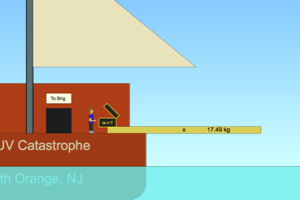
|
Make sure you can determine the amount of mass that you must place on a plank to allow you to walk to the end of the plank without cause it to rotate off the ship. |
|
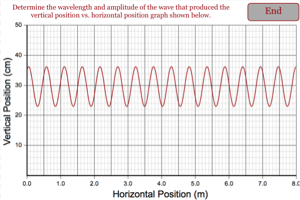
|
Determine the wavelength and amplitude of a wave based on the vertical position vs. horizontal position graph. |
|
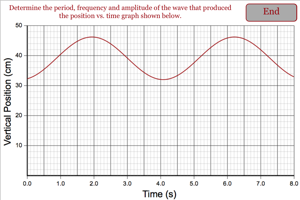
|
Determine the wavelength and amplitude of a wave based on the position vs. time graph. |
|
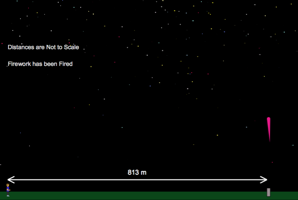
|
In this problem you must determine the height of a firework explosion above the ground. |
|
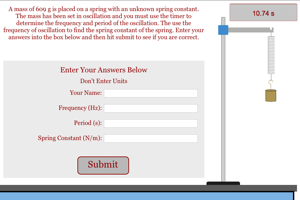
|
In this program you will need to find the period and frequency of an object oscillating on a spring. You will do this by timing enough oscillations to minimize your error to a low value. You will also use the frequency to find the spring constant of the spring based on the mass on the spring. |
|
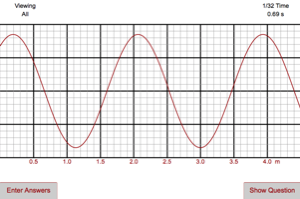
|
This program asks students to determine the variables in a wave equation. Students must determine wavelength, frequency, and amplitude. |
|
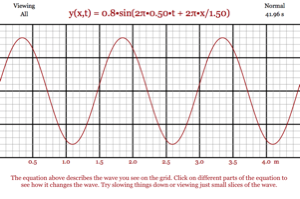
|
This program gives students a visual representation of the wave equation. This will let students see how all the different variables come together to create a wave that propagates through space and time. |
|
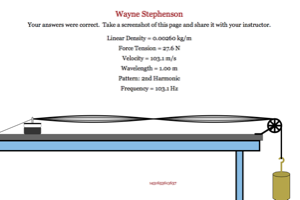
|
Determine the frequency needed to produced a given harmonic on a string with a given length, mass and tension. |
|
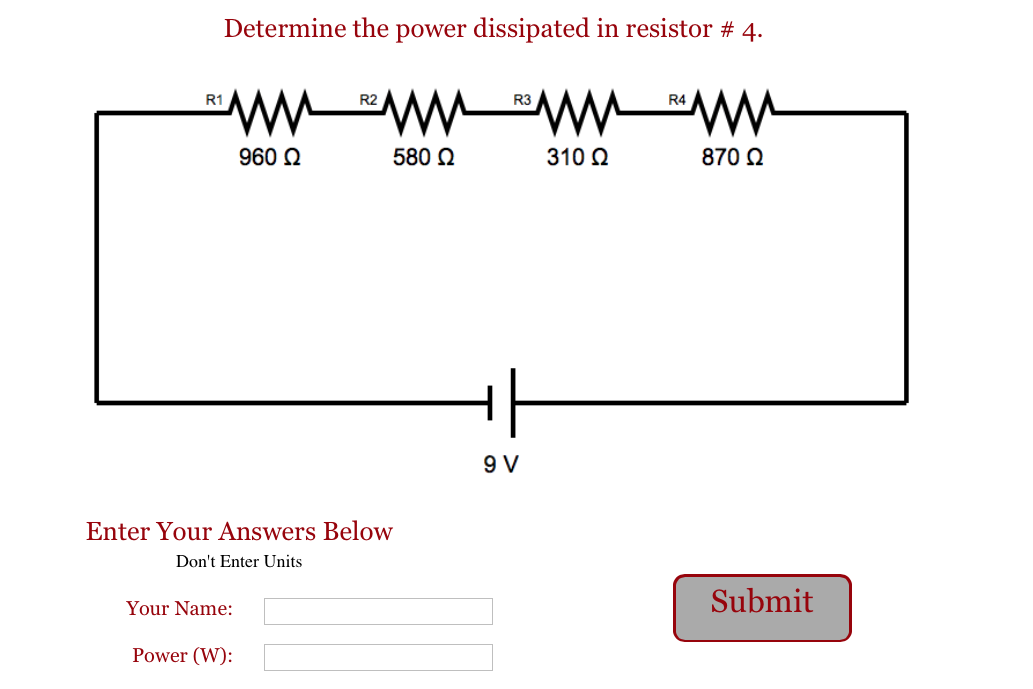
|
Make sure you can determine the amount of power dissipated in a resistor that is part of a series circuit. |
|
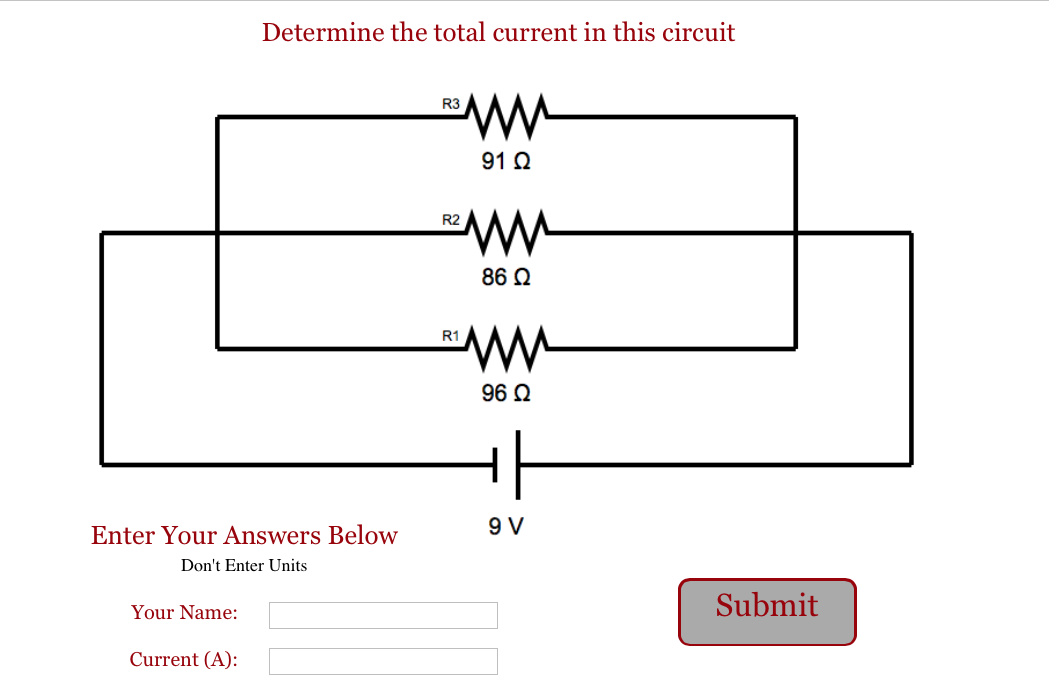
|
Make sure you can determine the amount of current that is present in a parallel circuit. |
|
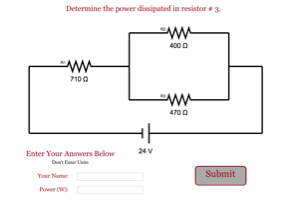
|
Make sure you can determine the amount of power dissipated in a resistor in a complex circuit. |
|
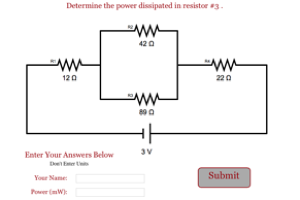
|
Determine the amount of power dissipated in a resistor in a complex circuit. |
|
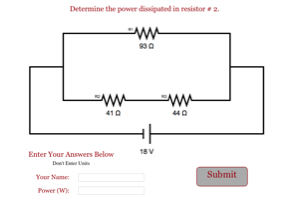
|
Make sure you can determine the amount of power dissipated in a resistor in a complex circuit. |
|